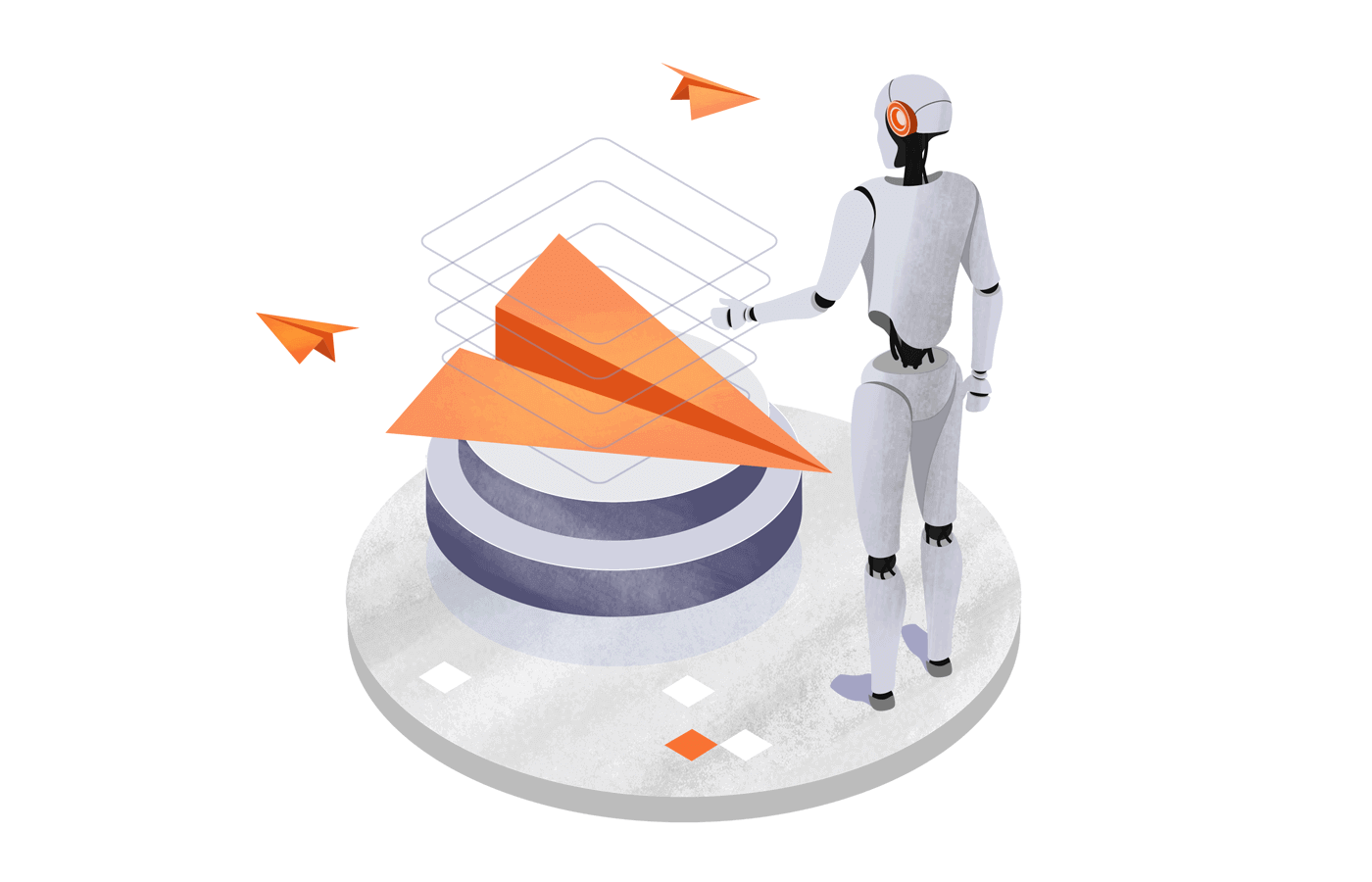As the world moves further into the digital age, email marketing remains a crucial aspect of a business’s marketing strategy. The rise of SaaS businesses has opened up new opportunities and, at the same time, has transformed how businesses approach email marketing.
In 2023, email marketing is expected to evolve even more, with new trends and technologies emerging. As a business owner, staying ahead of the game is crucial, so to help you with your email marketing efforts, we’ve compiled 7 SaaS email marketing strategies for 2023 to help you stay ahead of the curve.
Whether you’re a seasoned pro or just starting out, these strategies will help you maximize the impact of your email marketing campaigns and drive growth for your business.
7 Effective SaaS Email Marketing Strategies for 2023
From getting smarter with funnels to leveraging AI for ideation and content creation, here are 7 SaaS email marketing strategies to help your 2023 SaaS email marketing campaigns.
1. Creating Funnels, the Smart Way
Funnels…you’ve heard of that one before. Surely. But now it’s more important than ever to create them strategically and smartly. How?
Douglas McShane, Operations Director at Sheffield First Aid Courses, says, “Effective funnel creation begins with understanding the customer journey, recognizing unique paths and motivations at each stage.”
Create targeted email campaigns that address their needs and move them toward conversion.
The customer journey typically consists of three stages: Awareness, Interest, and Decision.
In the Awareness stage, the customer becomes aware of your product or service.
In the Interest stage, they are considering your product as an option. Finally, in the Decision stage, those visitors are paying customers.
This is how you can create a customer funnel:
- Awareness stage: Educate customers about your product and build brand awareness through email introductions and lead magnets (e.g., an ebook).
- Interest stage: Offer a free trial, demo, or webinar to encourage action and showcase how your product addresses their specific needs.
- Decision stage: Incentivize purchases with special promotions/deals and personalize the email with their trial usage and benefits of upgrading.
For example:
A SaaS business offering project management software. A customer searches for software signs up for a free trial, then upgrades to a paid account after being impressed with the software’s features and ease of use.
Customers expect seamless and personalized journeys, so making a well-crafted funnel is crucial in your SaaS email marketing strategy.
You can easily create a customer email funnel within Sender. With a human-friendly automation builder, it’ll take only a few clicks, and you’re done!
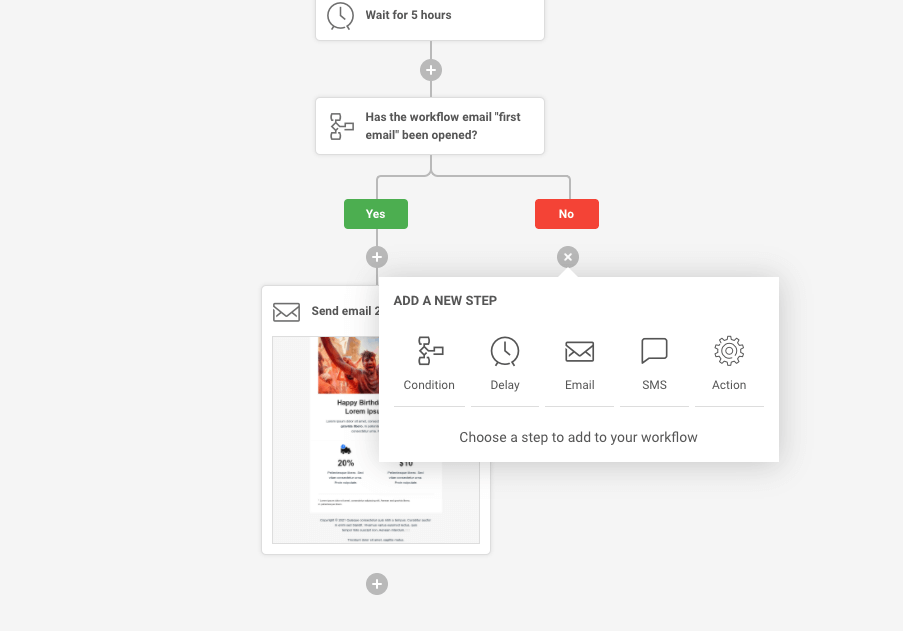
2. Focus on Offering Unique Lead Magnets
Lead magnets are a powerful tool in the email marketing toolkit, offering subscribers something of value in exchange for their email addresses. In 2023, it will be even more important to stand out and offer unique lead magnets to differentiate yourself from the competition.
But what does ‘uniqueness’ mean?
“Uniqueness” in lead magnets means offering something that is not commonly available and sets your lead magnet apart from others in the market. This can include personalization, exclusivity, and solving a specific problem for your target audience.
Here are some tips for creating a lead magnet:
- Research and understand your target audience
- Offer something that solves a specific problem or pain point for your target audience
- Offer a personalized experience, such as a customized assessment or quiz
- Offer a free trial or demo of your product or service
- Partner with other businesses to create a joint lead magnet
- Provide exclusive access to exclusive content or resources
- Create a lead magnet that is visually appealing and easy to consume
- Regularly update and refresh your lead magnet to keep it relevant and valuable to your target audience.
Jonathan Faccone, Managing Member & Founder of Halo Homebuyers says, “Lead magnets are essential in email marketing, and creating unique, personalized ones will help you stand out in 2023. Offering a tailored solution shows your commitment to providing the best possible experience for your customers.”
For example, have a look at the Sender’s Black Friday eBook landing page:
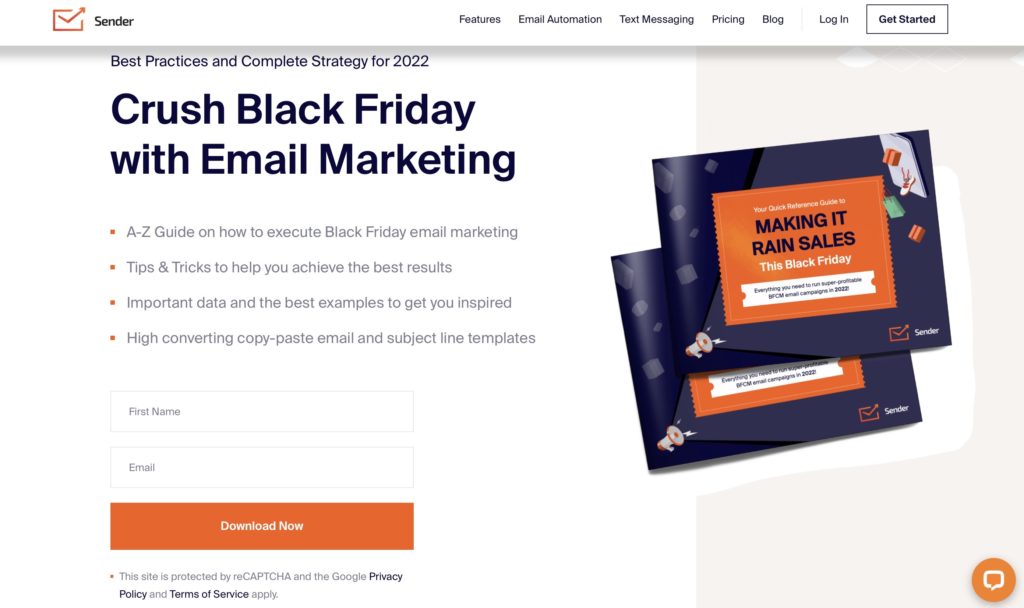
Let’s take another example. Let’s take a SaaS business that specializes in social media marketing and management software.
What unique thing could they offer?
Well, they could offer a unique lead magnet such as a “Social Media Audit” that comprehensively analyzes a subscriber’s current social media presence. The audit would cover areas such as profile optimization, content strategy, and engagement tactics and provide actionable recommendations for improvement.
A personalized lead magnet sets a company apart and shows commitment to customer satisfaction. If it feels like you’re giving too much for free, you could also offer it as a subscriber-only incentive to gather more email addresses and drive sales.
Also…
Measuring lead magnet success is crucial, track open rates, click-through rates, and conversions. Use analytics to make data-driven decisions and optimize your strategy for maximum impact.
3. Focus on Retaining Your Existing Clients
A crucial part of SaaS email marketing is customer retention, which keeps customers engaged and coming back for more.
Here are some tips on customer retention:
- Offer customized emails to customers who have completed a project with resources and tips for their next project
- Show customers that you care about their success and keep them engaged with the software and its features
- Offer special promotions and deals, such as exclusive discounts or early access to new features
- Foster strong relationships and increase customer retention by making customers feel valued and heard.
Talking about giving value…check this out. Squarespace gives a surprise by extending their free trial for the next 7 days.

Hamza G., Email Marketing Expert at Outreaching.io, explains, “Retaining existing clients is crucial in 2023 for SaaS businesses, especially with the increasing competition in the market. So you should absolutely consider revolving your email marketing strategy around retaining your existing clients.”
Pro Tip for Retention: Build a Community! Create a sense of community among customers by providing valuable resources, hosting events, and offering opportunities for customers to connect. For example, Sephora has a thriving online community where customers can connect and support each other
4. Upsell or Cross-Sell in a Way That’s NOT Pushy
Upselling and cross-selling are key components of any successful email marketing strategy. But you have to do it in a way that doesn’t sound ‘pushy’ or ‘scammy’.
Here are some more tips on cross-selling without coming across too pushy:
- Personalize your approach: Make sure your cross-selling efforts are tailored to each individual customer’s needs and preferences.
- Provide value: Offer customers products or services that complement their current purchases and can enhance their experience.
- Educate customers: Provide helpful information about the products or services you are offering and the benefits they will bring.
- Create bundles: Offer bundled packages of products or services that complement each other to make the customer’s shopping experience more convenient.
- Build trust: Build a strong relationship with your customers through excellent customer service and transparent communication. This will make them more likely to trust your recommendations.
- Respect the customer’s decision: Do not push your customers to make a purchase if they are not interested. Listen to their needs and be willing to answer any questions they may have.
- Offer incentives: Provide incentives for customers who take advantage of your cross-selling efforts. This could include discounts, free trials, or special promotions.
- Make the process easy: Ensure that the cross-selling process is as smooth and convenient as possible without adding extra steps or hurdles.
Take a cue from Grammarly — this is one of their successful email marketing campaigns. (A great way to upsell their premium plan.)

Talking about measuring success…
5. Keeping Track of Everything (Yes, That’s a Strategy in Itself)
Measuring the success of your email campaigns is a critical component of effective SaaS email marketing. With the right metrics in place, you can track the impact of your campaigns, identify areas for improvement, and make data-driven decisions for future campaigns.
Here’s how to implement this strategy:
- Identify Key Metrics to Track
There are several key metrics that you should track when measuring the success of your email campaigns. These include open rates, click-through rates, conversion rates, and customer engagement rates. Depending upon the goals, keep monitoring these metrics. These will determine the success of your campaigns.
- Use analytics and reporting tools
To track these metrics effectively, you’ll need to use an email marketing platform. There are many analytics and reporting tools available that can help you measure the success of your email campaigns. For example, if you’re using Sender, you can easily track everything in real time using our Advanced Analytics tool.
- Make data-driven decisions, forget intuition
With each day passing by, you’re moving into a data-driven world. Once you have the right metrics through email marketing software, make data-driven decisions for your future email marketing campaign. This includes identifying areas of improvement, testing new strategies, and continuously refining your approach to email marketing.
6. Use AI for Content Creation
Artificial Intelligence (AI) has revolutionized the marketing world, making it easier and more efficient than ever to reach and engage your target audience. Marketing automation is the new hype, and you shouldn’t be left behind.
AI tools like ChatGPT can help you generate ideas for new campaigns, create compelling content, and personalize it like never before. Not just email, AI can help bolster your entire SaaS marketing strategy.
Here’s how to do it:
- Analyze customer data: AI tools can analyze customer behavior and preferences to generate optimized content for maximum engagement. Do this by copying your customer reviews, pasting them in ChatGPT, and giving it a prompt to analyze the reviews and write your audiences’ personas, pain points, and more.
- Generate subject lines: Use AI tools to generate subject lines that are attention-grabbing and relevant to your audience.
- Create compelling CTAs: AI tools can create personalized call-to-action buttons that encourage subscribers to take action.
- Craft complete email bodies: AI tools can even generate complete email bodies that are tailored to your audience’s needs and preferences.
Even if you don’t want to write emails via an AI tool, you can still use them for inspiration to generate instant ideas, angles, and unique mechanisms.
For example, we asked ChatGPT to write me a humorous welcome email to my new subscribers to keep them hooked for future emails. Have a look and tell me it’s not engaging:
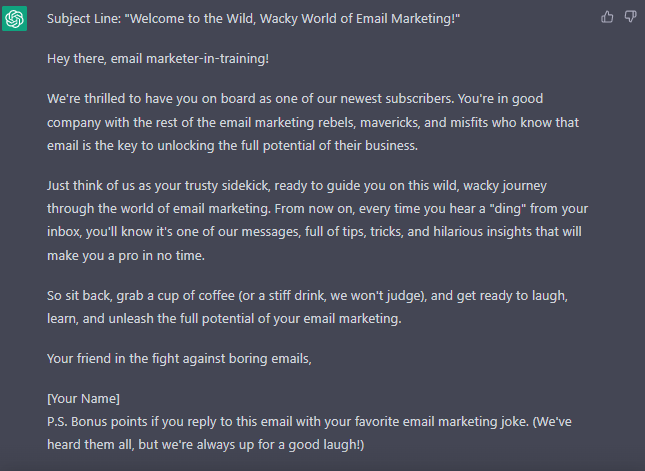
We could even go on and ask ChatGPT to create automated email sequences. The more creative you get with the tool, the more results you can reap.
Lastly…
7. Share Content that Actually Matters
Email marketing is a powerful tool for reaching your target audience and building a strong relationship with them. However, in the world of SaaS, where competition is fierce and the subjects are complex, it’s not enough to just send out any old email.
Brad Anderson, Founder of FRUITION, shares, Your email marketing strategy should be focused on helping your community. You need to educate. You need to help. You need to ensure that what you’re sending is valuable, relevant, and engaging. Share relevant content like weekly tips, news, resources, or freebies. Here’s how:
- Know your audience: Understand what your subscribers want and need from your emails.
- Offer value: Share content that offers value, such as tips, insights, or exclusive promotions.
- Be relevant: Ensure your share content that is relevant to your subscribers’ interests and needs.
- Provide a clear call-to-action: Encourage subscribers to take action by providing a clear call-to-action in your emails.
- Keep it concise: Use concise language to convey your message effectively.
- Personalize: Use personalization techniques, such as the subscriber’s name or location, to make the email more relevant.
- Test and optimize: Regularly test and optimize your emails to see what resonates best with your audience and make data-driven improvements.
For example, have a look at one of the great SaaS email marketing examples. EverAfter’s newsletter shares many value-filled ‘Treasure Trove’ for their subscribers.
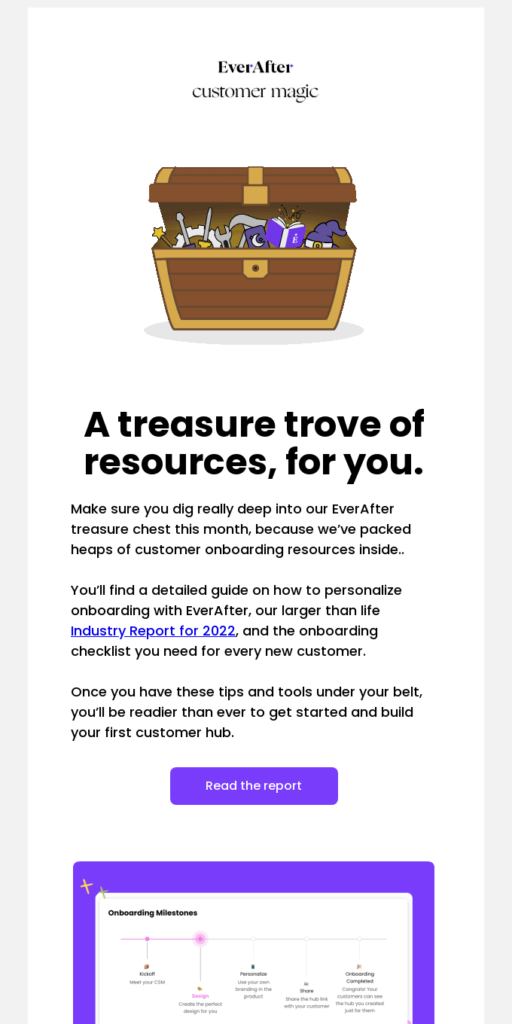
Key Takeaways: Best SaaS Email Marketing Strategies for 2023
Email marketing is a critical component of success for SaaS companies in 2023. With the right strategy, you can effectively create targeted email campaigns, offer unique lead magnets, retain customers, upsell and cross-sell, and measure success through data-driven decisions.
Here are the key takeaways to help you with your email marketing efforts:
- Targeted campaigns: Reaches specific customer segments with personalized messages for maximum engagement. You can set automated email sequences to do most of the tedious manual heavy lifting for you.
- Unique lead magnets: Offers subscribers something valuable in exchange for their email addresses, setting your business apart from competitors.
- Customer retention: Building relationships and community among customers, keeping them engaged with your business, and reducing churn.
- Upselling/Cross-selling: Offering additional products or services to existing customers, increasing overall revenue.
- Data-driven measurement: Analyzing key metrics, such as open rates, click-through rates, and conversions, to optimize email campaigns and make data-driven decisions.
We encourage you to keep learning and experimenting with new strategies, metrics, and tools to continually improve your email campaigns and drive better results for your business.
Also read: How to Build Effective SaaS Marketing Funnel
Author Bio
Kenny Kline is the founder and President at BarBend Inc, a strength sports media company. He primarily focuses on traffic generation, lead capture, and conversion for small businesses.
